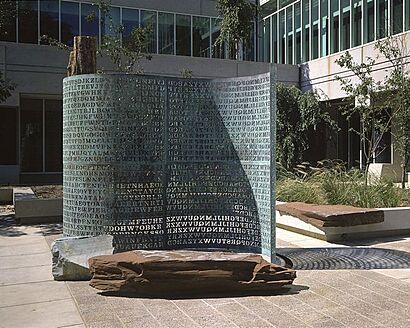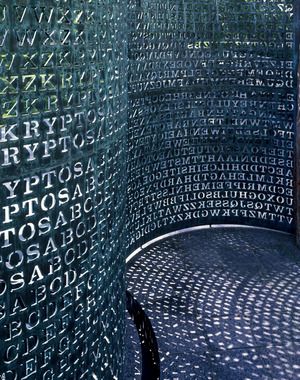Kryptos facts for kids
Quick facts for kids Kryptos |
|
|---|---|
 |
|
| Artist | Jim Sanborn |
| Year | 1990 |
| Location | George Bush Center for Intelligence, Langley, Virginia |
| 38°57′08″N 77°08′45″W / 38.95227°N 77.14573°W | |
Kryptos is a cool sculpture made by American artist Jim Sanborn. You can find it at the headquarters of the Central Intelligence Agency (CIA) in Langley, Virginia. It was put there on November 3, 1990.
Since then, many people have wondered about the secret messages hidden in the sculpture. There are four coded messages on Kryptos. So far, three of them have been solved! The fourth message is still a mystery, making it one of the most famous unsolved codes in the world. Many code-breakers, both pros and amateurs, are still trying to figure out the last part. The artist has even given out a few clues to help solve it.
Contents
What is Kryptos?
The main part of the sculpture is in the courtyard of the CIA's New Headquarters Building. It's made of four big copper plates. Other parts include water, wood, plants, red and green granite, white quartz, and petrified wood.
The most noticeable part is a large, S-shaped copper screen. It looks like a giant scroll or paper coming out of a printer. Half of this screen has secret text cut out of the copper. The text uses letters from the Latin alphabet and question marks. This main sculpture holds the four mysterious messages.
Artist Jim Sanborn also added other art pieces around the CIA grounds. These include large granite slabs with copper sheets. Some of these copper sheets have morse code messages. One stone slab even has a compass rose pointing to a special magnetic stone called a lodestone. There's also a garden, a fish pond, a reflecting pool, and other unique stone pieces.
The name Kryptos comes from an old Greek word meaning "hidden." The whole idea behind the sculpture is about "Intelligence Gathering," which means collecting secret information.
The Secret Messages
The left side of the main sculpture has 869 characters in total. These are 865 letters and 4 question marks.
In 2006, Jim Sanborn shared that one letter was left out on purpose. He said it was "for aesthetic reasons," meaning it made the sculpture look better.
There are also three words that are spelled wrong in the solved messages. Sanborn said this was done on purpose too! Plus, three letters (YAR) near the bottom of the left side are written a bit higher than the others, like a superscript.
The right side of the sculpture has a special code chart. It's called a keyed Vigenère encryption tableau and has 867 letters. This chart helps to decode the messages.
Other Sculptures by Jim Sanborn
Kryptos was the first sculpture Jim Sanborn made that used codes.
After Kryptos, he created several other sculptures with hidden codes and writings. Some of these include:
- Antipodes: This sculpture is at the Hirshhorn Museum in Washington, D.C.
- An "Untitled Kryptos Piece": This was sold to a private collector.
- Cyrillic Projector: This one has secret Russian Cyrillic text. It even included a part from a secret KGB document!
Interestingly, the code on one side of Antipodes is the same as some text from Kryptos. Also, much of the code on the other side of Antipodes is repeated on Cyrillic Projector. The Russian part of the code on Cyrillic Projector and Antipodes was solved in 2003.
Other sculptures by Sanborn feature texts from Native American cultures:
- Rippowam: Installed in 1999 at the University of Connecticut in Stamford.
- Lux: Placed in 2001 at an old US Post Office building in Fort Myers, Florida.
- Iacto: Located at the University of Iowa.
- Indian Run: Found near the U.S. Federal Courthouse in Beltsville, Maryland. This sculpture has a bronze cylinder with the text of the Iroquois Book of the Great Law. This important document shows how indigenous peoples helped shape the United States legal system. The text is in the Onondaga language and comes from the old stories of five Iroquois nations.
- A,A: Installed in 2004 at the University of Houston in Houston, Texas.
- Radiance: Installed in 2008 at Louisiana State University in Baton Rouge.
Images for kids
See also
 In Spanish: Kryptos para niños
In Spanish: Kryptos para niños
- Copiale cipher
- History of cryptography
- Voynich manuscript



